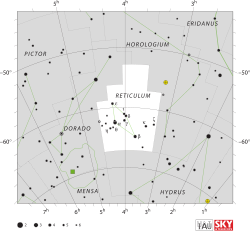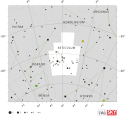Kappa Reticuli
| Kappa Reticuli (κ) | |
 | |
| Observationsdata Epok: J2000.0 | |
|---|---|
| Stjärnbild | Rombiska nätet |
| Rektascension | 03t 29m 22,67724s[1] |
| Deklination | -62° 56′ 15,0991″[1] |
| Skenbar magnitud () | +4,71[2] + 10,7[3] |
| Stjärntyp | |
| Spektraltyp | F3 V[4] eller F3 IV/V[5] + M1[6] |
| U–B | -0,04[2] |
| B–V | +0,39 ± [2] |
| Astrometri | |
| Radialhastighet () | +12,5 ± 0,4[7] km/s |
| Egenrörelse (µ) | RA: +382,84 ± [1] mas/år Dek.: +373,05 ± [1] mas/år |
| Parallax () | 46,12 ± 0,13[1] |
| Avstånd | 70,7 ± 0,2 lå (21,68 ± 0,06 pc) |
| Absolut magnitud () | +2,98[8] |
| Detaljer | |
| Massa | 1,32[9] M☉ |
| Radie | 1,1[10] R☉ |
| Luminositet | 5,16[11] L☉ |
| Temperatur | 6 796 ± 231[9] K |
| Metallicitet | -0,07[12] |
| Vinkelhastighet | 13,5 ± 0,7[13] |
| Ålder | 848[9] miljoner år |
| Andra beteckningar | |
| κ Ret, 4 Reticuli , CD-63° 112, FK5 126, HD 22001, HIP 16245, HR 1083, SAO 248819, WDS J03294-6256A [14] | |
Kappa Reticuli (κ Reticuli, förkortat Kappa Ret, κ Ret) som är stjärnans Bayerbeteckning, är en dubbelstjärna[3] belägen i den västra delen av stjärnbilden Rombiska nätet. Den har en skenbar magnitud på 4,71[2] och är synlig för blotta ögat där ljusföroreningar ej förekommer. Baserat på parallaxmätning inom Hipparcosuppdraget på ca 46,1[1] mas, beräknas den befinna sig på ett avstånd på ca 71 ljusår (ca 22 parsek) från solen. Baserat på dess rymdhastighetskomponenter ingår stjärnan i stjärnhopen Hyaderna som delar en gemensam rörelse genom rymden.[15]
Egenskaper
Primärstjärnan Kappa Reticuli A är en gul till vit stjärna i huvudserien av spektralklass F3 V[4]. Den har en massa som är omkring 30 procent[9] större än solens massa, en radie som är omkring 10 procent[10] större än solens och utsänder från dess fotosfär ca 5[11] gånger mera energi än solen vid en effektiv temperatur på ca 6 800[9] K.
Houk och Cowley (1978) katalogiserade den gula[16] primärstjärnan som en stjärna av spektraltyp F med blandade egenskaper hos en huvudseriestjärna och en mer utvecklad underjättestjärna[5]. Senare listade Gray et al. (2006) den med spektralklass F3 V,[4] som anger att den är en ren huvudseriestjärna av spektraltyp F. Den emitterar ett statistiskt signifikant överskott av infraröd strålning, vilket tyder på närvaro av en omgivande stoftskiva. [17] Följeslagaren Kappa Reticuli B är en orange[16] stjärna av spektraltyp M1[6] med en skenbar magnitud på 10,4 separerad med 54 bågsekunder från primärstjärnan.[3]
Referenser
- Den här artikeln är helt eller delvis baserad på material från engelskspråkiga Wikipedia, tidigare version.
Noter
- ^ [a b c d e f] van Leeuwen, F. (2007), "Validation of the new Hipparcos reduction", Astronomy and Astrophysics, 474 (2): 653–664, arXiv:0708.1752 , Bibcode:2007A&A...474..653V, doi:10.1051/0004-6361:20078357.
- ^ [a b c d] Johnson, H. L.; et al. (1966), "UBVRIJKL photometry of the bright stars", Communications of the Lunar and Planetary Laboratory, 4 (99): 99, Bibcode:1966CoLPL...4...99J.
- ^ [a b c] Eggleton, P. P.; Tokovinin, A. A. (September 2008), "A catalogue of multiplicity among bright stellar systems", Monthly Notices of the Royal Astronomical Society, 389 (2): 869–879, arXiv:0806.2878 , Bibcode:2008MNRAS.389..869E, doi:10.1111/j.1365-2966.2008.13596.x.
- ^ [a b c] Gray, R. O.; et al. (July 2006), "Contributions to the Nearby Stars (NStars) Project: Spectroscopy of Stars Earlier than M0 within 40 parsecs: The Northern Sample I", The Astronomical Journal, 132 (1): 161–170, arXiv:astro-ph/0603770 , Bibcode:2006AJ....132..161G, doi:10.1086/504637.
- ^ [a b] Houk, Nancy; Cowley, A. P. (1978), "Michigan catalogue of two-dimensional spectral types for the HD stars", University of Michigan Catalogue of two-dimensional spectral types for the HD stars. Volume I. Declinations -90_ to -53_ƒ0, Ann Arbor: Dept. of Astronomy, University of Michigan, 1, Bibcode:1975mcts.book.....H.
- ^ [a b] Gaidos, E.; Mann, A. W.; Lépine, S.; Buccino, A.; James, D.; Ansdell, M.; Petrucci, R.; Mauas, P.; Hilton, E. J. (2014). "Trumpeting M dwarfs with CONCH-SHELL: A catalogue of nearby cool host-stars for habitable exoplanets and life". Monthly Notices of the Royal Astronomical Society. 443 (3): 2561. arXiv:1406.7353 . Bibcode:2014MNRAS.443.2561G. doi:10.1093/mnras/stu1313.
- ^ de Bruijne, J. H. J.; Eilers, A.-C. (October 2012), "Radial velocities for the HIPPARCOS-Gaia Hundred-Thousand-Proper-Motion project", Astronomy & Astrophysics, 546: 14, arXiv:1208.3048 , Bibcode:2012A&A...546A..61D, doi:10.1051/0004-6361/201219219, A61.
- ^ Reiners, A. (January 2006), "Rotation- and temperature-dependence of stellar latitudinal differential rotation", Astronomy and Astrophysics, 446 (1): 267–277, arXiv:astro-ph/0509399 , Bibcode:2006A&A...446..267R, doi:10.1051/0004-6361:20053911.
- ^ [a b c d e] David, Trevor J.; Hillenbrand, Lynne A. (2015), "The Ages of Early-Type Stars: Strömgren Photometric Methods Calibrated, Validated, Tested, and Applied to Hosts and Prospective Hosts of Directly Imaged Exoplanets", The Astrophysical Journal, 804 (2): 146, arXiv:1501.03154 , Bibcode:2015ApJ...804..146D, doi:10.1088/0004-637X/804/2/146.
- ^ [a b] Pasinetti Fracassini, L. E.; et al. (February 2001), "Catalogue of Apparent Diameters and Absolute Radii of Stars (CADARS)", Astronomy and Astrophysics (Third ed.), 367 (2): 521–524, arXiv:astro-ph/0012289 , Bibcode:2001A&A...367..521P, doi:10.1051/0004-6361:20000451.
- ^ [a b] https://www.universeguide.com/star/kappareticuli Arkiverad 17 augusti 2018 hämtat från the Wayback Machine.. Hämtad 2018-08-16.
- ^ Casagrande, L.; et al. (2011), "New constraints on the chemical evolution of the solar neighbourhood and Galactic disc(s). Improved astrophysical parameters for the Geneva-Copenhagen Survey", Astronomy & Astrophysics, 530 (A138): 21, arXiv:1103.4651 , Bibcode:2011A&A...530A.138C, doi:10.1051/0004-6361/201016276.
- ^ Ammler-von Eiff, M.; Reiners, A. (June 2012), "New measurements of rotation and differential rotation in A-F stars: are there two populations of differentially rotating stars?", Astronomy & Astrophysics, 542: 31, arXiv:1204.2459 , Bibcode:2012A&A...542A.116A, doi:10.1051/0004-6361/201118724, A116.
- ^ "kap Ret". SIMBAD. Centre de données astronomiques de Strasbourg. Hämtad 2017-07-14.
- ^ Montes, D.; et al. (November 2001), "Late-type members of young stellar kinematic groups - I. Single stars", Monthly Notices of the Royal Astronomical Society, 328 (1): 45–63, arXiv:astro-ph/0106537 , Bibcode:2001MNRAS.328...45M, doi:10.1046/j.1365-8711.2001.04781.x.
- ^ [a b] Streicher, Magda (December 2009), "Reticulum: The Celestial Crosshairs", Monthly Notes of the Astronomical Society of South Africa, 68 (11–12): 242–246, Bibcode:2009MNSSA..68..242S.
- ^ Gáspár, András; et al. (May 2013), "The Collisional Evolution of Debris Disks", The Astrophysical Journal, 768 (1): 29, arXiv:1211.1415 , Bibcode:2013ApJ...768...25G, doi:10.1088/0004-637X/768/1/25, 25.
Externa länkar
| ||||||||||||||||
Media som används på denna webbplats
Författare/Upphovsman: IAU and Sky & Telescope magazine (Roger Sinnott & Rick Fienberg), Licens: CC BY 3.0
IAU Reticulum chart


